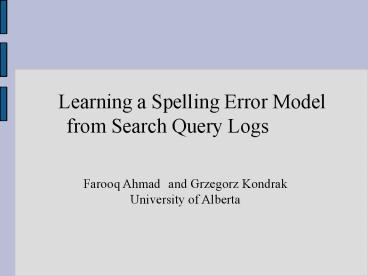Learning a Spelling Error Model from Search Query Logs
1 / 23
Title:
Learning a Spelling Error Model from Search Query Logs
Description:
search a dictionary for the closest match, using levenshtein edit distance ... Test of 508 Misspelled Dictionary Words. Corrections Returned are Ranked by Probability ... –
Number of Views:67
Avg rating:3.0/5.0
Title: Learning a Spelling Error Model from Search Query Logs
1
Learning a Spelling Error Model from Search Query
Logs
Farooq Ahmad and Grzegorz KondrakUniversity of
Alberta
2
Overview
- Motivation and Prior Work
- Learning an Error Model
- Results
- Future Work
3
Background
- Motivation
- Over 700 M search queries made every day
- 10 misspelled
- Problems
- Queries are often not found in a dictionary
- Eg. multiplayer, blog, federline
- Many possible candidate corrections for any given
misspelled query
4
Motivation
- Blue Dictionary Words
- 27 of unique types
- 80 of all words
- Yellow Non-Dictionary Words
- 73 of token types
- 20 of all words
Token Frequency vs Rank for Dictionary and
Non-Dictionary Words
5
What are these non-dictionary words?
6
Possible Approaches
- 1. Naïve Method
- search a dictionary for the closest match, using
levenshtein edit distance - returns minimum number of insertions,
deletions,and substitutions to transform one word
to another - Assigns a uniform cost to every substitution
- the best word is the one with minimum edit
distance from the misspelled word - Why not just use Levenshtein?
- eg. britny - briny vs. britney
7
Better Method
- 2. Incorporate a Language Model
- use levenshtein edit distance and word
probability to select best match - Use Levenshtein to find candidate words
- Rank candidates by word probability
- Mayes, Damerau 1991
- Spelling Correction using bigram language model
Levenshtein edit distance
8
Even Better...
- 3. Use probabilistic edit distance and word
probability - probabilistic edit distance
- each type of insertion, deletion and substitution
has its own edit cost EC - eg. P(e i ) P(e z) so we want EC(e
i ) z) - word probability
- use unigram, bigram, or trigram probabilities
- eg. Unigram Probability P(wi) c(wi)/N
- How do we integrate these probabilities?
9
Noisy Channel Model
- Basic Noisy Channel Model
- Kernighan, Church, Gale 1990
- Use a dictionary to find candidates w within 1
edit of v - Given misspelled word v, find best w
- What do we want?
- Language model P(w)
- Error model P(vw)
10
Language Model
- Can an be determined from query logs
- Brill, Moore 2004
- N-gram language Model derived from search queries
- Log thousands (millions) of search queries
- http//www.metacrawler.com/perl/metaspy
- real-time display of search queries processed by
the metacrawler search engine - compile word probabilities (Unigram, Bigram, etc)
11
Error Model
- P of misspelling v given word w
- depends on the probability of each edit operation
- Taking the log of both sides gives
- How do we relate Edit Cost (lower is better)
and probability (higher is better)? - EC(e) -logP(e) (Ristad, Yianilos 1997)
- So, ED(v,w) -logP(vw)
12
Learning the Error Model
- How do we find the edit probabilities P(e)?
- Use a hand compiled list of spelling errors and
their corrections - Compile statistics on the edit operations
- OR...
- use the language model to determine the error
model using expectation maximization
13
Expectation Maximization
- Soft Clustering (EM)
Assign the data point (v) to each cluster (w) in
proportion to how well it fits the cluster
P(vw), P(w)
Given a data point (possibly misspelled word v)
and clusters (possible corrections wi )
Update the cluster centers (edit costs) to
reflect the inclusion of the new data
14
Use EM to find Edit Distances
- Start with a naïve error model
- Use Expectation Maximization to improve it
- For each query v
- Determine the most likely candidate corrections
using the existing edit distance model and
language model (E-Step) - for each candidate word wi within ED(x)
- candidates args max n P(vwn)P(wn)
- P(vw) ?P(ek)
- one candidate may be the word itself
- Update the edit distance model (M-Step)
15
M-Step
- M-Step
- Given P(e1...en)
- each ek is a single ins, del, or sub of two
letters - want to adjust P(e1).. P(e2) accordingly
- Update Frequency Table
- F(ei) P(wi)
- Normalize
- P(ei) F(ek) / N
- N total number of edit operations for that letter
- Convert into Edit Distance
- D(ek) -log(P(ek))
16
EM Example
- E and M-Step working together
E-Step
Update
Frequency Table
Normalization
Example P(equipment equibmnt) 0.11 ee,
qq, uu, ii, pb, mm, e_, nn, tt
D -log(P)
Probability Table
Edit Distance Table
17
Example
- Say we are using a bigram language model and see
the following bigram - High scopl (v scopl)
- 1. Find all possible candidate corrections w and
their probabilities
18
EM Example
- E and M-Step working together
P(school scopl) P(ss, cc, h_, oo,
op, ll) 0.11
19
ResultsMost Common Letter Substitutions
20
Results Letter Insertion Probabilities
21
Evaluation
- Test of 508 Misspelled Dictionary Words
- Corrections Returned are Ranked by Probability
- Percentage of times that the correct word was
within the Top 1,5,25 of the returned corrections
22
Future Work
- Better Language Model (Word Bigrams)
- New jeresy 5
- New jers 1
- New jersery 3
- New jerseu 1
- New jersey 4
- New jersey 4654
- New jersy 19
- New jersye 1
- Use Letter Context
- (condition on previous letter lT-1)
- eg. sofen - soften
- P(t-_f) instead of just P(t-_)
- Transpositions
- their thier
- Use a stemmer
- hot dog hot dogs
23
Questions?































